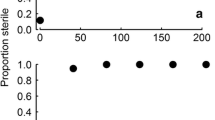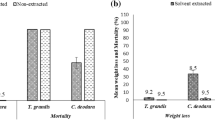Abstract
Industrial roundwood is an important commodity with global trade of 125 million m3 in 2016. Fumigation is the main phytosanitary treatment for bulk wood commodities. Joule heating is a potential alternative phytosanitary treatment for export Pinus radiata D. Don (Pinaceae) logs, but its effectiveness against insects has not yet been confirmed experimentally. To define treatment parameters for Joule heating, we quantified the thermal tolerance of two forest insects, Hylurgus ligniperda (Fabricius) (Scolytinae) and Arhopalus ferus (Mulsant) (Cerambycidae) that are potentially present on P. radiata logs. Heat was applied using dry bath heat blocks to life stages present when phytosanitary treatments are applied. Arhopalus ferus eggs were the most heat-tolerant life stage with decreasing tolerance at 30 min of H. ligniperda adults > H. ligniperda larvae > A. ferus adults, > A. ferus larvae, H. ligniperda eggs, and H. ligniperda pupae. Additional testing of A. ferus eggs (in dry and humidified environments) determined that an upper LT99.99 with 95% confidence of 55.6 °C applied for 30-min controlled A. ferus and hence all other life stages. This is within the range of published studies of other bark- and wood-boring insects, which are reviewed. The LT99.99 and wood-borer biology are discussed in the context of Joule heating as a potential phytosanitary treatment for bulk wood exports. Joule heating of 32 test logs (3.3 m long) demonstrated temperatures exceeding 60 °C for at least 60 min. Ten logs infested with H. ligniperda were Joule-heated to the same profile, resulting in 100% mortality of adults and larvae. Our results are consistent with current ISPM 15 treatment parameters and show that Joule heating is an effective, non-chemical, alternative option to fumigation for quarantine pest control.






Similar content being viewed by others
References
Aukema JE, McCullough DG, Holle BV, Liebhold AM, Britton K, Frankel SJ (2010) Historical accumulation of nonindigenous forest pests in the continental United States. Bioscience 60:886–897
Brockerhoff EG, Hosking GP (2001) Arhopalus tristis (F.) (Coleoptera: Cerambycidae) (= Arhopalus ferus (Mulsant)): burnt pine longhorn beetle. For Timber Insects N Z 27(Revised):1–8
Brockerhoff EG, Bain J, Kimberley M, Knížek M (2006) Interception frequency of exotic bark and ambrosia beetles (Coleoptera: Scolytinae) and relationship with establishment in New Zealand and worldwide. Can J For Res 36:289–298. https://doi.org/10.1139/x05-250
Brockerhoff EG, Barratt BIP, Beggs JR, Fagan LL, Kay MK, Phillips CB, Vink CJ (2010) Impacts of exotic invertebrates on New Zealand’s indigenous species and ecosystems. N Z J Ecol 34:158–174
Cown DJ (1999) New Zealand pine and douglas-fir: suitability for processing. Rotorua New Zealand: Forest Research Bulletin 216. Forest Research
Dentener PR, Lewthwaite SE, Rogers DJ, Meier X, Whiting DC, McDonald RM (2001) Heat treatments for control of huhu beetle (Prionoplus reticularis larvae in logs). N Z J For Sci 31:273–286
Ellis JC (2011) A log volume formula for exporters. N Z J For 56:20–26
Eyre D, Haack RA (2017) Invasive cerambycid pests and biosecurity measures. In: Wang Q (ed) Cerambycidae of the world: biology and pest management. CRC Press, Boca Raton, pp 563–607
FAO (2016) Global forest products facts and figures (2016). http://www.fao.org/3/I7034EN/i7034en.pdf
Fleischer HO, Downs LE (1953) Heating veneer logs electrically. Technical report, United States Department of Agriculture, Forest Service, Forest Products Laboratory, Madison, WI
Goebel PC, Bumgardner MS, Herms DA, Sabula A (2010) Failure to phytosanitize ash firewood infested with emerald ash borer in a small dry kiln using ISPM-15 standards. J Econ Entomol 103:597–602
Haack RA et al (2014) Effectiveness of the international phytosanitary standard ISPM No. 15 on reducing wood borer infestation rates in wood packaging material entering the United States. PLoS ONE 9:e96611. https://doi.org/10.1371/journal.pone.0096611
Hansen LS, Jensen KMV (1996) Upper lethal temperature limits of the common furniture beetle Anobium punctatum (Coleoptera: Anobiidae). Int Biodeterior Biodegrad 37:225–232
Heffernan B (2013) Practical application of joule heating to the sterilization of plantation grown Pinus radiata logs. Presentation to the Electricity Engineers’ Association of New Zealand, 19-21 June 2013, Auckland, New Zealand. http://www.epecentreacnz/docs/research/EEA%20Log%20Joule%20Heating%20Paper%20revF.pdf
Hoover K, Uzunovic A, Gething B, Dale A, Leung K, Ostiguy N, Janowiak JJ (2010) Lethal temperature for pinewood nematode, Bursaphelenchus xylophilus, in infested wood using microwave energy. J Nematol 42:101–110
Hosking GP, Bain J (1977) Arhopalus ferus (Coleoptera: Cerambycidae); its biology in New Zealand. N Z J For Sci 7:3–15
IPPC (2008) IPPC recommendation: replacement or reduction of methyl bromide as a phytosanitary measure. Appendix 6. Report of the Third Session of the Commission on Phytosanitary Measures, Rome, 7–11 Apr 2008, p 10
IPPC (2016a) ISPM 15: regulation of wood packaging material in international trade. 2013-04 CPM-8 adopted revised Annex 1 to ISPM 15 with consequential changes to Annex 2. Rome, IPPC, FAO. Publication history: Last modified June 2016
IPPC (2016b) ISPM 28: phytosanitary treatments for regulated pests. 2007-03 CPM-2 adopted standard. Adopted 2007; published 2016:11
Jones DP (2010) Biomedical sensors. Momentum Press, New York
Kim J, Suh SJ (2014) Lethal temperature against Japanese pine sawyer, Monochamus alternatus, in infested wood using microwave energy. J Agric Life Sci 48:33–40
Luna EK, Sitz RA, Cranshaw WS, Tisserat NA (2013) The effect of temperature on survival of Pityophthorus juglandis (Coleoptera: Curculionidae). Environ Entomol 42:1085–1091. https://doi.org/10.1603/EN13151
Mackes K, Costanzo T, Coleman R, Eckhoff M, Vaughan D (2016) Protocol for heat treating black walnut wood infested with walnut twig beetle. For Prod J 66:274–279. https://doi.org/10.13073/fpj-d-14-00082
Mayfield AE III, Fraedrich SW, Taylor A, Merten P, Myers SW (2014) Efficacy of heat treatment for the thousand cankers disease vector and pathogen in small black walnut logs. J Econ Entomol 107:174–184
MBIE (2015) Nominal annual average fuel prices. New Zealand Ministry for Business, Innovation, and Employment. http://www.med.govt.nz/sectors-industries/energy/energy-modelling/data/prices. Accessed 18 Aug 2015
McCullough DG et al (2007) Effects of chipping, grinding, and heat on survival of emerald ash borer, Agrilus planipennis (Coleoptera: Buprestidae), in chips. J Econ Entomol 100:1304–1315
Meurisse N, Pawson S (2017) Quantifying dispersal of a non-aggressive saprophytic bark beetle. PLoS ONE. https://doi.org/10.1371/journal.pone.0174111
MPI (2016) Ephyto: electronic phytosanitary system. https://epcsp.maf.govt.nz/MAF.PhytoECert.Web/Home/Login?ReturnUrl=%2fMAF.PhytoECert.Web%2f. Accessed Nov 2016
MPI (2018) Forestry statistics: quarterly production and trade information, Ministry for Primary Industries, Wellington. https://www.mpi.govt.nz/news-and-resources/statistics-and-forecasting/forestry/. Accessed 8 Feb 2018
Mushrow L, Morrison A, Sweeney J, Quiring D (2004) Heat as a phytosanitary treatment for the brown spruce longhorn beetle. For Chron 80:224–228
Myers SW, Bailey SM (2011) Evaluation of a heat treatment schedule for the Asian longhorned beetle, Anoplophora glabripennis (Coleoptera: Cerambycidae). For Prod J 61:46–49
Myers SW, Fraser I, Mastro VC (2009) Evaluation of heat treatment schedules for emerald ash borer (Coleoptera: Buprestidae). J Econ Entomol 102:2048–2055
Nursultanov N (2018) Joule heating of green Pinus radiata logs for phytosanitary purposes: an in-depth investigation by experimentation and computational modelling. Chemical and Process Engineering Department, College of Engineering, University of Canterbury, New Zealand
Nursultanov N, Altaner C, Heffernan WJB (2017) Effect of temperature on electrical conductivity of green sapwood of Pinus radiata (radiata pine). Wood Sci Technol 51:795–809. https://doi.org/10.1007/s00226-017-0917-6
Nzokou P, Tourtellot S, Kamdem DP (2008) Kiln and microwave heat treatment of logs infested by the emerald ash borer (Agrilus planipennis Fairmaire) (Coleoptera: Buprestidae). For Prod J 58:68–72
Palmer DJ, Kimberley MO, Cown DJ, McKinley RB (2013) Assessing prediction accuracy in a regression kriging surface of Pinus radiata outerwood density across New Zealand. For Ecol Manag 308:9–16. https://doi.org/10.1016/j.foreco.2013.07.024
Pang S, Keey RB, Langrish TAG (1995) Modelling the temperature profiles within boards during the high-temperature drying of Pinus radiata timber: the influence of airflow reversals. Int J Heat Mass Transf 38:189–205
Pawson SM, Watt MS, Brockerhoff EG (2009) Using differential responses to light spectra as a monitoring and control tool for Arhopalus ferus (Coleoptera Cerambycidae) and other exotic wood-boring pests. J Econ Entomol 102:79–85. https://doi.org/10.1603/029.102.0112
Pawson SM, Williams N, Gear I, Armstrong JW (2014) Reducing biosecurity business risks for logs and timber. N Z J For 59:36–42
Payette M, Work TT, Drouin P, Koubaa A (2015) Efficacy of microwave irradiation for phytosanitation of wood packing materials. Ind Crops Prod 69:187–196. https://doi.org/10.1016/j.indcrop.2015.01.030
Perré P (2004) Electrical heating of green logs using Joule’s effect: a comprehensive computational model used to find a suitable electrode design. Wood Sci Technol 38:429–449
Sauvard D (2004) General biology of bark beetles. In: Lieutier F, Day KR, Battisti A, Grégoire JC, Evans HF (eds) Bark and wood boring insects in living trees in Europe, a synthesis. Kluwer, Dordrecht, pp 63–88
Sobek S, Rajamohan A, Dillon D, Cumming RC, Sinclair BJ (2011) High temperature tolerance and thermal plasticity in emerald ash borer Agrilus planipennis. Agric For Entomol 13:333–340
Suh SJ (2014) Lethal temperature for the black timber bark beetle, Xylosandrus germanus (Coleoptera: Scolytidae) in infested wood using microwave energy. Curr Res Agric Life Sci 32:131–134
R Development Core Team (2017) R: a language and environment for statistical computing. Version 3.3.3. R Foundation for Statistical Computing, Vienna, Austria. ISBN:3-900051-07-0. http://www.R-project.org/
Uzunovic A, Gething B, Coelho A, Dale A, Janowiak JJ, Mack R, Hoover K (2013) Lethal temperature for pinewood nematode, Bursaphelenchus xylophilus, in infested wood using radio frequency (RF) energy. J Wood Sci 59:160–170
Van Epenhijusen CW, Sommerfield KG, Hedderley D (2012) Rearing and storing Arhopalus ferus life stages in the laboratory for experimental purposes. N Z J For Sci 42:15–23
Wang Y et al (2003) Preliminary study on efficacy of heat treatment against Anoplopora nobilis in poplar wood. Plant Quar 17:326–329
Acknowledgements
The authors thank John Ellis of C3 Ltd. for providing additional log metric data to estimate the cost of applying heat as a phytosanitary treatment for New Zealand log exports. This work was funded by the Stakeholders in Methyl Bromide Reduction and the New Zealand Ministry for Business, Innovation and Employment via Scion’s core Funding (Contract C04X1104) through the Better Border Biosecurity Collaboration (www.b3nz.org).
Author information
Authors and Affiliations
Corresponding author
Ethics declarations
Conflict of interest
Pawson and Heffernan have received research grants from Stakeholders in Methyl Bromide Reduction.
Ethical approval
All applicable New Zealand guidelines for the care and use of animals were followed.
Additional information
Communicated by J. D. Sweeney.
Special Issue on Invasive Pests of Forests and Urban Trees.
Electronic supplementary material
Below is the link to the electronic supplementary material.
Supplementary Table S1
Number of individuals and replicates treated in each of phase 1 and 2 testing and the PT100 temperatures recorded per replicate in phase 2. Refer to excel file (XLSX 13 kb)
Rights and permissions
About this article
Cite this article
Pawson, S.M., Bader, M.KF., Brockerhoff, E.G. et al. Quantifying the thermal tolerance of wood borers and bark beetles for the development of Joule heating as a novel phytosanitary treatment of pine logs. J Pest Sci 92, 157–171 (2019). https://doi.org/10.1007/s10340-018-1015-8
Received:
Revised:
Accepted:
Published:
Issue Date:
DOI: https://doi.org/10.1007/s10340-018-1015-8




